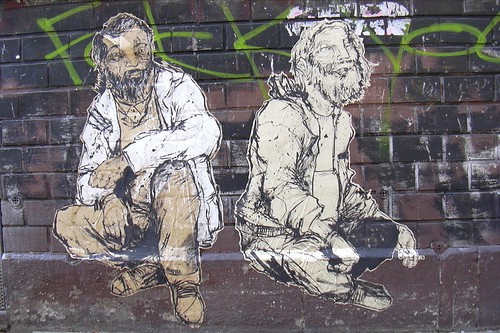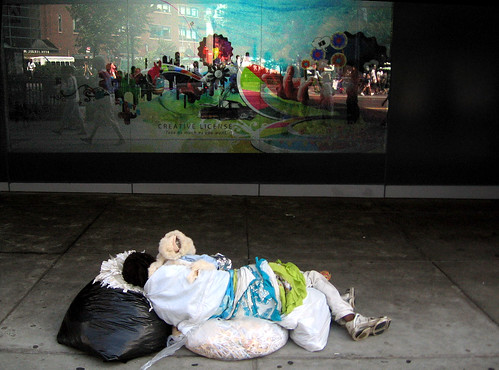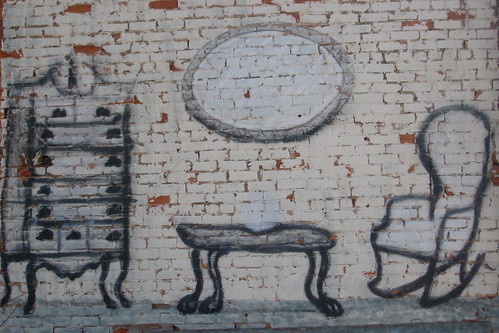(noon. – promoted by ek hornbeck)
US President and Nobel Peace Prize winner Barack Obama last winter signed the American Recovery and Reinvestment Act of 2009, appropriating $1.5 billion for a Homeless Prevention and Rapid Re-housing Program (HPRP). These monies are being distributed via a formula used for the Emergency Shelter Grant (ESG).
HUD, oversees the funding and serves as the hub for information on the program, And the National Alliance to End Homelessness (NAEH) is working alongside to ensure the successful implementation of HPRP.
This Sunday, BrokenRoots shines a light on HPRP: How’s it doing so far? What are its guidelines and philosophy? Who’s eligible and how is HPRP defining homelessness? And, perhaps more significantly, as the days grow shorter and the temps drop, what are YOU doing about the homeless crisis in your own backyard? We’ll provide a few suggestions and solicit some ideas.
If it’s Sunday, It’s ‘Homeless in America”

HUD’s $1.5 billion funding for the Homeless Prevention and Rapid Re-housing Program (HPRP) is divvied up into grants to assist communities most devastated by the current financial disaster to provide “short- and medium-term rental assistance and services to prevent individuals and families from becoming homeless or to quickly re-house those who are experiencing homelessness.”
The funding, part of $300 million awarded nationwide, will rapidly re-house families who fall into homelessness, or prevent families from becoming homeless in the first place. The funding, provided through the American Recovery and Reinvestment Act of 2009, is also designed to help persons and families facing a sudden financial crisis that could lead to homelessness.
To date, HUD has obligated $10 billion, nearly 75 percent, of the Department’s $13.61 billion in Recovery Act grants, thereby allowing State and local communities to begin spending these funds. Today’s announcement means all $1.5 billion in Homelessness Prevention and Rapid Re-Housing funds have been awarded.
“HUD is moving quickly to ensure that Recovery Act investments can be put to work helping those who are in desperate need during these challenging times,” said Donovan. “Today, we are proud to announce that all of the Homelessness Prevention and Rapid Re-Housing funds made available through the Recovery Act are in the hands of those on the front lines of helping families and individuals confronting homelessness. I am thrilled that in just over six months we have made $10 billion available for states and communities to spend, creating jobs and helping families impacted by the tough economic times.” link
The last of the $3.1 million from HPRP was awarded in September to two communities in Rhode Island. The City of Providence which received $2,303,402; and the City of Pawtucket, awarded $845,934. Link
So what’s the scivvy on HPRH?
Although preliminary reports are just beginning to file in, HUD’s HOMELESSNESS RESOURCE EXCHANGE is doing an exemplary job in its role of information portal. And, in conjunction with HUD, the National Alliance to End Homelessness (NAEH), is showcasing up-to-date information and providing comprehensive guides to materials which demonstrate HPRP’s strategic shift: A Housing First approach. Perhaps the most powerful of NAEH’s resources are
Homelessness Prevention: Creating Programs that Work and Best Practices, which includes a video about New York City’s HomeBase program, considered one of the country’s most successful homelessness prevention programs. Also noteworthy: NAEH’s Prevention Models

At the 86th street Subway station along the 1,2, and 3 line, there is an art display. This particular attempt at art was unique in that rather that glorifying New York City, it accurately portrayed the dispersion of human filth into public facilities. Here, a homeless man is shown sleeping on a bench. It’s fairly evident that New York City has several social problems, and homelessness is rampant.
As defined by HPRP guidelines, the definition of homeless individuals eligible for funding include individuals who meet one of the following guidelines: 1.sleeping in an emergency shelter; 2.sleeping in a place not meant for human habitation; 3. staying in a hospital or institution for up to 180 days, but literally homeless immediately prior to entry; 4. graduating from/timing out of transitional housing; and 5.fleeing domestic violence
So how’s it going? According to today’s rec list diary Panic in Detroit 35,000 showed up in Detroit Wednesday morning to apply for just over $18 million for the entire state of Michigan in HPRP funding. (Notes: Detroit has been allocated some $15 million in direct HPRP funds, with $3 million going to the State of Michigan for a total of just over $18 million; 2006 census figures show employment in Detroit at around 30%, with a population of around 871,121 Link)
“The purpose of this funding is to prevent people from losing their homes or to quickly re-house individuals who have recently become displaced from their homes.” Link

In Evansville Indiana, information on the $2.7 million available to citizens of both Evansville and Vanderburgh County offers a pre-screen online survey to determine eligibility for housing assistance.
Up in Maine, Catholic Charities Catholic Mental Health Services has been funded to operate the Engaging and Housing Stabilization program throughout Kennebec and Somerset Counties “allowable financial assistance for housing and related needs of homeless individuals with apparent or diagnosed mental health issues who face significant challenges to becoming stabilized in housing. Use of these funds should alleviate hardship brought about by the economic disadvantages inherent with mental illness, and to address existing unmet needs.”

This is the impressive work of an unknown (to me) street artist. I found this painted on a wall in Porto. I understand this as the plea of a homeless little girl as she seeks a shelter. The words “Home Less Home” were written nearby.
Meanwhile, in California, with the largest homeless population in the country, the government has thrown $42.7 million at the problem Link, while next door, in Oregon, where there are 17,122 homeless, the state received $7.8 million, and continues to work on its 10 year plan: A Home for Hope

In Nassau County, New York, $6,458,35.00 in HPRP funds is available to provide rental assistance, housing relocation, and stabilization services for families and individuals during the economic crisis. There eligibility requirements state: Eligible recipients of HPRP benefits include individuals and families with children who have incomes at or below 50% of the area medium income, which is currently $101,800 for a family of four; those who have no appropriate housing options identified; those who lack sufficient resources and support networks to maintain existing housing after the 18-month period of assistance ends; future affordability is a key component of eligibility for HPRP funds and must be financially independent and able to maintain their residence within the 18 month time frame allowed by the program. link
Homelessness: Make it real. ‘Own’ it where you live!
From its origins in San Francisco where it was pioneered by Mayor Gavin Newsom, and building on models of response to Katrina and Stand Downs for veterans, Project Homeless Connect has been identified by the United States Interagency Council on Homelessness as an innovation that can move people more quickly toward housing and stability and furthers the goals of community 10 Year Plans to end homelessness. With encouragement and technical assistance from the Council, Project Homeless Connect has now been adopted by more than 200 communities, large and small, in the U.S., Canada, and Australia in less than three years. Link
National Homeless Connect week is Dec. 7-13. Visit the ICH for a calendar of upcoming PHC events, a downloadable toolkit for holding an event in your community.

Homeless Heart: Picture and Poem
Resources
Recovery.gov – see where the money is going report on potential fraud, waste, and abuse.
Info Center on American Recovery and Reinvestment Act of 2009

Opportunities to Help
1. Support Homeless Artists: Hearts of Fire, a nonprofit organization is committed to celebrating and supporting the art of the homeless. Visit their Cafe Press storefront to purchase some of their creations.
2. Volunteer: San Francisco Project Homeless Connect: Next date Wednesday, October 28. “At each PHC event more than 1,000 individuals from every sector of the Bay Area work together to provide efficient and compassionate service to those in need. Volunteers lead and manage most service areas from calling on personal and business resources, to developing collaborative relationships between agencies, to setting up chairs and tables. The common goal is to provide relevant and easily accessible onsite services for clients while creating a valuable experience for all volunteers.”
3. Hud’s What Can I do to help?
4. 35 Ways you can help the homeless
5. Help Homeless School Children in Augusta, Georgia
6. How to volunteer at a local homeless shelter
Photo credits:
Homeless guy likes Bansky art by londondan
The art of ignoring those in need by lorenzondom
Homeless art by cityrat
Homeless heart by poeticverse
Homeless by occ4m
Homeless Home by Dan Gammekk
Homeless Gallery by Tyla’75
“BrokenRoots is a group for writers, photographers, and advocates interested in addressing the issues facing the homeless, primarily as a result of the current financial crisis. Our goal is to engage readers to report in on homeless issues in their communities, either by posting information into one of our diaries, or by contributing a diary or a photo-essay. The BrokenRoots project team writes and promotes diaries and other journalism; forges connections with other blogs, news sources, and organizations; creates collaborative projects; and shares related news and resources.” (photo by Stranded Wind)

1 comments
Author
for helping to bring some prominence to this subject!